
If you’re a wine-loving history buff with a penchant for War of 1812 battle lore, then read on…
In my last blog post I outlined the issues leading up to the War of 1812, wherein the Americans invaded – or at least attempted to invade – Canada.
It was not America’s finest hour: most historians agree they bungled most of these land invasions, leaving Canada’s colonial fate firmly in the hands of the British (ish). They also realized a professional army vs an untrained volunteer militia and drunken cadre of rusty ‘revolutionary’ generals might serve them better in any future invasions (thankfully, we’ve been BFFs for the last 200+ years so this scenario has not come to pass).
The War of 1812 was a nation-defining experience for Canada. We were young, a mish-mash of cultures, creeds and colonialists, all on land settled by Canada’s 630 First Nations communities.
In researching this story, I discovered very few of my American relatives or friends know anything about this war, yet it spawned the American flag, the star-spangled banner and many made-in-the-US military colloquialisms (Yankees, Uncle Sam, Brother Jonathan).
I, on the other hand, grew up in Winnipeg in central Canada on Queenston Street (a famous 1812 battle). One street west was Brock (an 1812 legend). One street east was Niagara (ground zero).
Between my #buylocal passion for Niagara wine and my personal geography growing up, I figure it is my sworn duty to tell this nation-defining story.

Photo credit: The War of 1812 Website
As I mention above, blog #1 provides a broad – who, what, when, where, why – overview of the war. This blog (#2) highlights the politics of the time and specific battles and skirmishes in Niagara. Should you proceed to blog #3 – which tours wineries with an 1812 history – you’ll want to reference these notes. Consider this your ‘wine & war’ cheat sheet.
It’s important to know the eighteenth and nineteenth centuries were defined by political and military conflicts in Great Britain, Europe and the British North American colonies of British America and British Canada. Post American Revolution, there remained a myriad of complex international issues that underpinned the hostilities between the United States, Great Britain and by default, British Canada. It’s this simmering powder keg that fueled the War of 1812 (or, more precisely, the War of 1812 – 1814).
In true form, the US military was pathologically confident that seven and a half million Americans could easily over-power half a million Canadians (the census in 1812).
“It will be a mere matter of marching,” said Thomas Jefferson. “Three months for the conquest of Canada.”
“I believe that in four weeks from the time a declaration of war is heard on our frontier, the whole of Upper Canada and a part of Lower Canada will be in our power.”- Jeffersonian Republican, Head of Foreign Relations Committee and ‘War Hawk’ John C. Calhoun, 1812
“Heaven grant us success and Canada will be ours,” U.S.Brigadier-General Pike.
Interestingly, all 98 members of the House and Congress who voted in favor of war with British Canada were Republicans. Not a single Federalist voted to go to war.
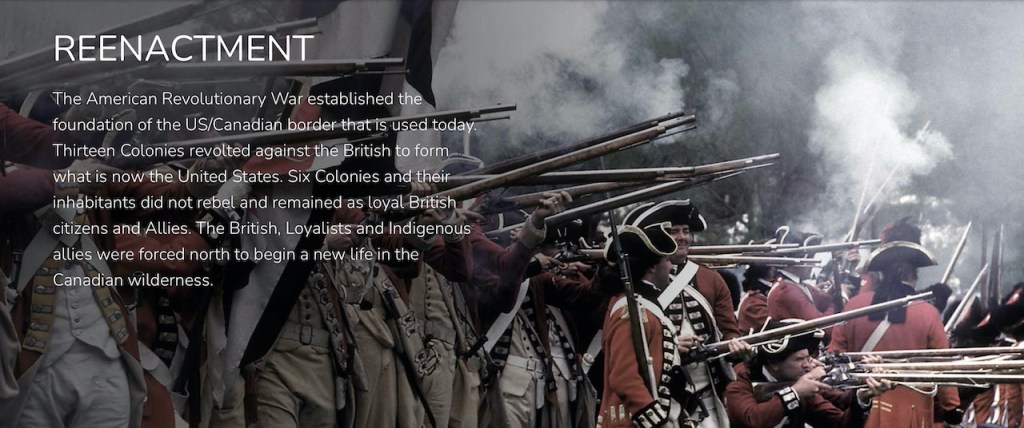
Causes of the War of 1812
Here’s your high-level timeline from a Niagara Region perspective. You’ll need to know this when you tour Niagara wineries (blog 3) and yes, there will be a test :-).
1756 – 1763 – Seven Years’ War – When the French/British war ended in 1763, 70,000 French colonists came under British rule, setting in motion the ever-evolving French-English dynamic in Canada.
1775–1783 – The American Revolution – American colonists win independence from Great Britain. The colonists’ uprising stems from a taxation system deemed unfair, Britain having royal powers over the 13 colonies, and frustration over British ships blocking American trade ships in European ports.
1775 – 1776 – American revolutionary rebels invade British Canada and attempt to convince the Province of Quebec (Lower Canada) to take up arms against the British. The invasion fails and a mass exodus of 40,000+ American loyalists, supporting the British Crown, begin to migrate north into ‘the Canadas’. The King’s Royal Regiment of New York or King’s Royal Yorkers is formed in Canada to exact loyalist revenge in New York and with Indian Department Rangers, Six Nations Indians, and Joseph Brant’s volunteers they suppress rebels.

July 4, 1776 – The American Declaration of Independence is drafted by Thomas Jefferson sealing the US’s divorce from Great Britain.
Sept, 1783 -The Treaty of Paris, acknowledges the end of the American Revolution and recognizes the independence of the United States. The surrendering of all lands west of the Ohio River to the newly-formed United States shocks Indigenous Peoples in the west.
1787-1799 – French Revolution – France’s costly involvement in the American Revolution, an outdated feudal system, extravagant spending by the wildly unpopular monarch King Louis XVI (and his predecessor) and unequal rights amongst the bourgeoise, leaves France on the brink of bankruptcy.

1799 – 1815 – The Napoleonic Wars – a series of wars between France and other European powers. Financial pressures mounting, in 1803 Napoleon sells the Louisiana Territory, to the US government including the entire western basin of the Mississippi River. The acquisition doubles the size of the US land mass, and in many areas displaces Native Americans, destroying their way of life.
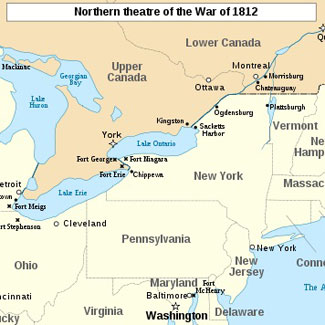
1791 – The provinces of Lower Canada and Upper Canada, two historical British colonies are formed, when the British Parliament passed the Constitutional Act, splitting the colonial Province of Quebec into two separate colonies. The flood of Crown loyalists after the revolution and the Paris Treaty requires new lands and a larger expanded Canada. Loyalists start settling in Upper Canada. NOTE: today it’s estimated 1 in 10 Canadians come from this loyalist migration.

1811 (summer) – In 1811, Shawnee Chief Tecumseh attempted to negotiate with the American government to stop western expansion into native lands along the Great Lakes. He travelled throughout the United States gathering supporters and allies to form a confederacy of native tribes that could resist westward expansion by white settlers. “I want the present boundary line to continue … should you cross it … I assure you it will be productive of bad consequences.”—Shawnee leader Tecumseh Negotiation failed, violence erupted and – fearing the ‘revolutionary genius’ of Tecumseh – Indiana governor Harrison sends the US army to Prophetstown to burn down the headquarters of the Confederacy. Tecumseh and his followers flee north to Upper Canada and align with the British.
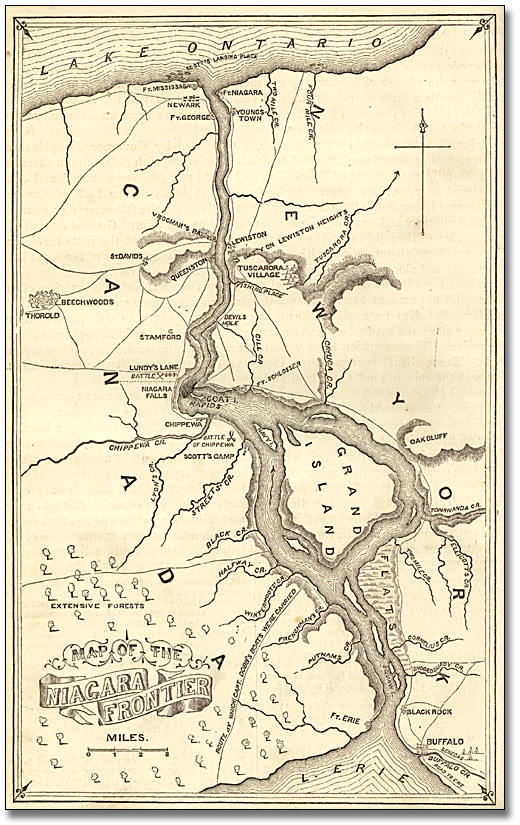
Major 1812 Battles/Events
June 18, 1812 – The United States declares war on Great Britain invading Upper Canada, Lower Canada and Atlantic Canada. War hawks in Congress predict a four-week war is required to take Upper Canada. Chief irritants: British interference and trade restrictions on the US as a side-effect of Britain’s seemingly endless war with France, the British protocol of forcing American merchant sailors into the Royal Navy (impressment) and British support for Native Americans fighting the US government’s westward expansion. Assuming an easy go of it, the American government rejects a bill to finance the army, opting instead to send local militia into battle.

July 6, 1812 – The Siege of Detroit, also known as the Battle of Fort Detroit, is an early battle in western Upper Canada (Sandwich – now Windsor area) in the British-U.S. War. Early heroes emerge in First Nations commander Tecumseh, Grand River Iroquois leader John Norton, and British Major-General Sir Isaac Brock. American forces under Brigadier General William Hull, governor of the Michigan Territory, are twice ambushed by Indigenous forces and eventually surrender to the significantly smaller British and First Nations forces in Detroit. Canadian military tactics outwit Hull and the US is humiliated and humbled, losing Michigan, Wisconsin and a part of Minnesota.
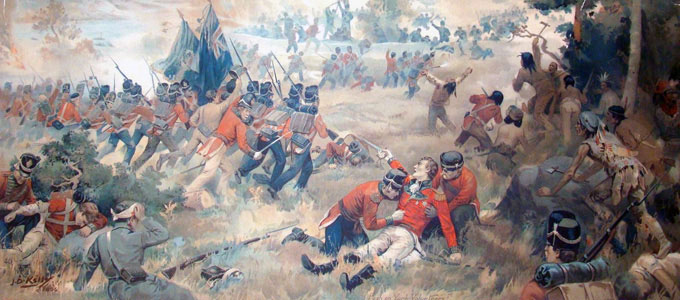
October 13, 1812 – Battle of Queenston Heights. At dawn, 600 American soldiers cross the Niagara River at Queenston Heights, the principal port and trading hub for the British supply ships coming to Upper Canada. While American are able to take the Heights, the much smaller Queenston contingent famously thwarts the American invasion thanks to an alliance and flanking maneuver between Grand River First Nations warriors, British soldiers, and the local farmer-led militia.
Leader of British Canadian forces, British Major-General Sir Isaac Brock dies in battle along with his aide-de-camp John Macdonell. A planned second American invasion is an embarrassment, when the second contingent of militia fail to cross the Niagara River to support American soldiers. As with Detroit, Indigenous war chants scare off Americans. Almost 1,000 American POWs are captured.
April 25 – 30, 1813 – American amphibious forces cross Lake Ontario, capturing the poorly defended ship-building port of Fort York, now Toronto (Battle of York). British captain Tito LeLièvre destroys the munitions armoury in a massive explosion that results in five times more American casualties than British Canadian. The Upper Canada Parliament Buildings are burned by American soldiers as they exit, a reprehensible practice amongst warring factions.
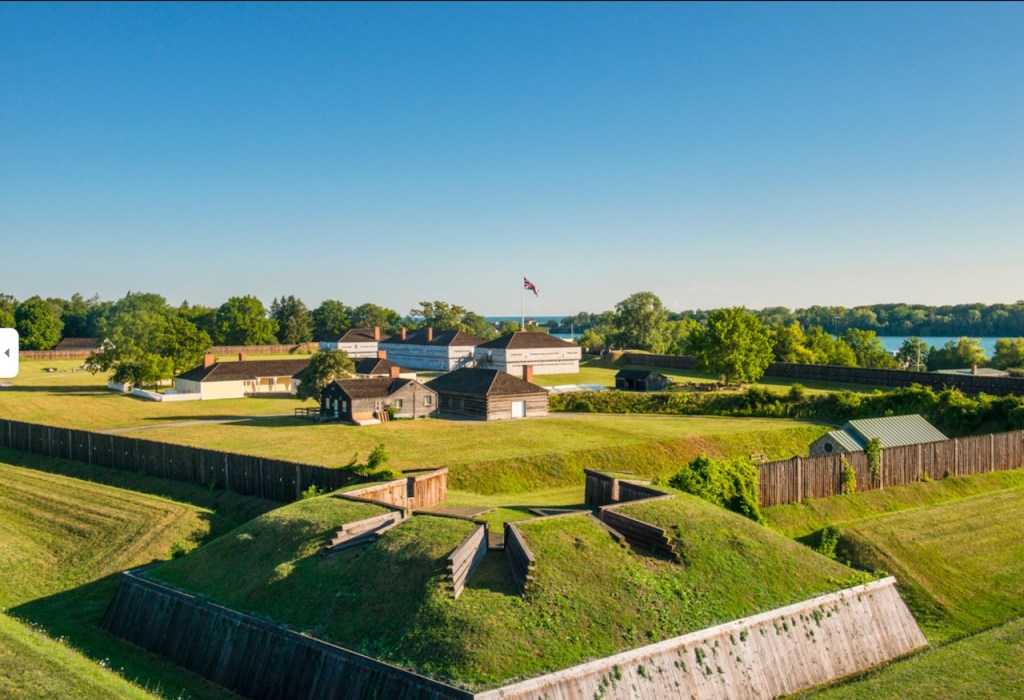
May 25, 1813 – Siege of Fort George. Americans launch a massive artillery bombardment and amphibious attack near the mouth of the Niagara River with 6,000 troops and 140 vessels. Considered a textbook military operation, soldiers capture the British garrison and scale the banks of the Niagara River taking hold of smouldering Fort George. Outnumbered four to one, American forces burn down Fort George taking over the ruins of the Fort and the neighbouring town of Niagara. British soldiers are forced to retreat to Burlington Heights (port near Hamilton).
June 6, 1813 – Battle of Stoney Creek – 700 British troops march from Burlington Heights to an American encampment near Stoney Creek. Described as a donnybrook in the park, the British surprise the Americans in a night attack relying on a single bayonet charge. American forces are decapitated and forced back to Fort George

June 24, 1813 – Queenston resident and housewife Laura Secord is forced to billet American soldiers from Fort George. Overhearing battle plans from drunken soldiers in her home (she plies them with apple cider), she walks 19 miles/30 km through woods and swamps to the headquarters of the British outpost up on the Niagara Escarpment. First Nations warriors help guide her to the Decew House to warn Lieut. James Fitzgibbon of an impending attack.
June 26, 1813 – Battle of Beaverdams – A decisive defeat of American troops by a First Nations force. Two days after Laura Secord shares her military intelligence, 685 American soldiers are ambushed and captured as they march to the Decew outpost. The battle is almost exclusively led by 545 First Nations forces, including the Six Nations on the Grand River led by Captain John Brant and Captain William Johnson Kerr and the Kahnawake, Tyendinaga, Kanesatake Mohawk warriors from Lower Canada, led by Captain Dominique Ducharme.
July 31, 1813 – American forces invade Fort York…. again.
Sept 10, 1813 – Americans take Detroit back in a naval battle for control of Lake Erie (9 American vs 6 British warships)

October 25 – 26, 1813 – Battle of Châteauguay – under French-Canadian Lieutenant-Colonel Charles de Salaberry (1778–1829), an all-Canadian fighting force including native allies – Mohawk, Wendat, Algonquin and Abenaki, a full-time contingent of professional Lower Canada soldiers Canadian Voltigeurs and Canadian militia drive out 3,000 attacking US forces from Burlington, Vermont, preventing their attempted capture of Montreal.
November 11, 1813 – Battle of Crysler – the second US military campaign and another botched attack by the Americans to capture Montreal. Although greatly outnumbered, the battle on John Crysler’s farmland manages to keep the American troops from Sackets Harbor, New York from taking over Eastern Ontario and capturing Montreal.
December 10, 1813 – Burning of Newark/Niagara on the Lake – Besieged by British and First Nations forces, the American army abandons Fort George, looting and burning the town of Newark and leaving residents homeless in the middle of winter. Considered bad military form.
December 19, 1813 – British assault across the Niagara River on the American’s Fort Niagara. The British would retain this post for the remainder of the War of 1812. In a retaliatory campaign for the wanton destruction of Newark in Upper Canada, the British and Canadian armies burn most communities between Lewiston and Buffalo, New York.
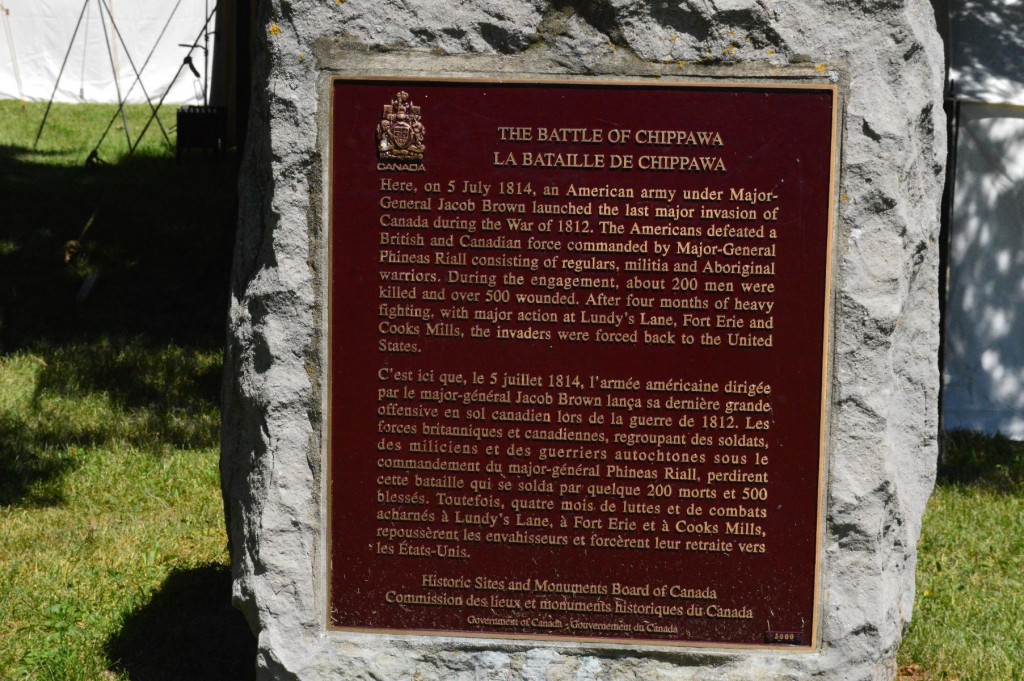
July 5, 1814 – Battle of Chippewa – a victory for the US forces, who had just crossed the Niagara River with 4,000 men and taken Fort Erie. Marching north to Burlington and Toronto (yet again), they were attacked by 2,000 British regulars and Canadian militia from Fort George at Chippewa, along the lower Niagara River. (Note: also spelled Chippawa)
July 20, 1814 – Guilty of Treason – Eight men are hanged at Burlington Heights for high treason and taking up arms against the government of Upper Canada. They are beheaded, their heads displayed on poles and their bodies buried in unmarked graves in what is today Hamilton’s Inchbury neighbourhood. The punishment is a sobering warning to cavalier Americans who were trading Canadian military strategy for promises of permanent US residence after the war.
July 22, 1814 – ‘Untrained’ New York civilian militia and ‘treasonous’ Canadian volunteers destroy the village of St. Davids on the trade-heavy Portage Road as they march south to the battle in Niagara Falls.

July 25, 1814 – Battle of Lundy’s Lane – the bloodiest, most hard-fought battle in the War of 1812. Lieutenant General Gordon Drummond’s summons 2800 men to take on the advancing American Army. Six hours later, 800 Americans and 800 British Canadian soldiers are killed, wounded or missing. American soldiers fail to advance and retreat to Fort Erie, crossing the Niagara River back into Buffalo.
August, 18 – 24, 1814 – Burning of Washington DC – As retribution for atrocities at Fort York (April 27, 1813) and Newark (Dec 10, 1813), British and Canadian troops from Upper and Lower Canada march south into Washington setting fire to the capital buildings, Library of Congressm the treasury, navy yard and the White House. They meet little opposition, the President James Madison has fled and the 7,000 hastily gathered militia force are little more than “motley rabble”.
December 24, 1814 – Peace Treaty of Ghent – with the Napoleonic War over, and America defaulting on its national debt loans, and important American victories in Plattsburgh, Baltimore and New Orleans the two warring nations agree to peace. All land is handed back to the rightful owner and prisoners of war, released. The British fails to secure a dedicated Indian Territory for American Natives, as was promised and Indigenous peoples north and south of the border are considered the losers of this war. Americans also ignore the treaty article calling for restoration of all Indigenous lands to 1811 conditions.
Death toll at the end of the War of 1812 is estimated at 23,600 for British, Canadian and American soldiers. The number of Indigenous casualties is not known.
Sources consulted and further reading are provided at the end of blog 1
Blog 3 introduces wine lovers to Niagara wineries rooted in the War of 1812. Read on…..

Very informative, superb research and nicely presented. Love all the priceless imagery and support material.
LikeLike
You must be a teacher!! haha! Thanks v much.
LikeLike